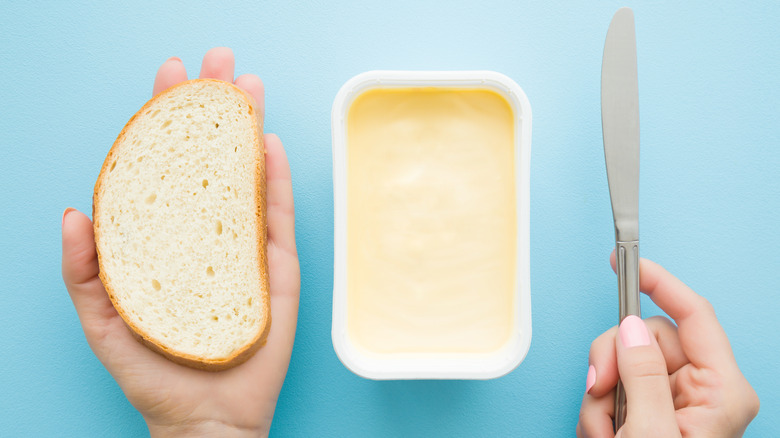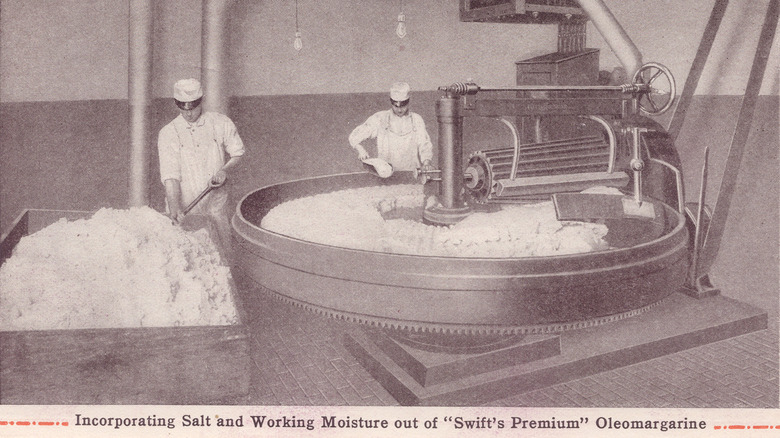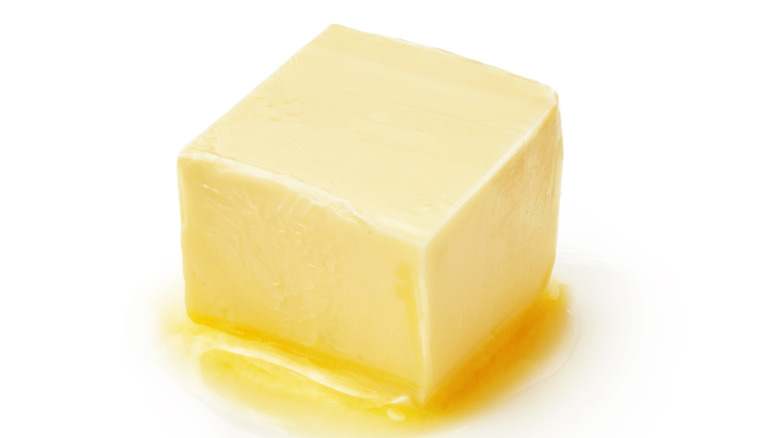What Is Margarine Really Made Of?
Margarine is a butter alternative that's ebbed and flowed in popularity (and production, too) over time. Current margarines are typically a mix of water and oil, such as soybean, corn, palm, canola, or olive oils (via Healthline). While many margarines are plant-based due to these ingredients, other may still contain animal products. Popular non-vegan additives may include milk, lactose, whey, or casein, so it's important to check your labels if you have dietary or allergy restrictions.
In addition, margarines may contain some additional non-veggie ingredients like animal fat, tallow, or suet — throwbacks to historical margarine creation. Some producers will use marine oil, which is made from seafood. Vitamin D3 sounds veggie-forward, but is commonly made from sheep's wool (posted at US National Library of Medicine). You may also see lecithin, which is a fatty additive that can sometimes be produced from animal tissues or egg yolks. Depending on the manufacturer, you may also see salt or other seasonings. And while today's margarine's are a little confusing, these ingredients have definitely evolved over time.
A short history of margarine
Original margarine probably wasn't what you expect today. The first version is credited to meet demand for a cheaper non-butter alternative during the Franco-Prussian war (via Science Direct). In 1860 in France, Hippolyte Mèges-Mouries created a butter substitute using beef tallow churned with milk. This butter alternative wouldn't gain mass production until 1902, when Wilhelm Normann of Germany learned how to harden food oils using a process called hydrogenation, which meant vegetable oils could replace the limited beef tallow.
The direct competition in the butter world upset dairy workers and owners who then lobbied against the widespread oil-based alternative. It wasn't until 1969 that the use and production of margarine became widespread across Europe and the United States. Around 2000 margarine became the tablespread of choice for many who also appreciated its ease in cooking and frying.
While margarine production and consumption peaked, it would then fall out of favor in the health battle between margarine and butter as medical guidance for consumers changed.
The margarine vs butter health wars
At one time we were supposed to eat butter, then we were told margarine was healthier, then butter again, dairy issues, keto — there's so much conflicting advice that many people are still very confused. The facts are that most of this advice has been well-intentioned, but perhaps not well researched. There isn't one simple answer to the "what is best" (via Harvard Health). Butter should be used sparingly because it's high in saturated fat, which isn't great for your heart. Older margarines had lower saturated fat, but higher trans fats, which are actually even worse for your health. These trans fats lowered your good cholesterol and raised your bad cholesterol, basically doubling the health risk. And for many, it didn't taste quite right, either.
Modern-day margarines and butter alternatives, however, may be healthier than either of the originals. Even healthy spreads, however, have calories, so don't forget to account for all the nutritional information. More brands are using healthier oils, such as olive oil. There vegetable oil-based spreads that contain mono- and polyunsaturated fats, and there are now stanol-based spreads, too which can even help lower your cholesterol. Fortunately, there are just so many kinds to choose from now.
Vegan spreads are taking butter alternatives to a whole new level
The rise of better vegan options has greatly expanded the margarine and non-butter selections available to most of us. A huge factor in this expansion is the avoidance of palm oil in production — a more environmentally friendly and sustainable way to create our favorite schmear (via Food 52). New butter alternatives have also gotten more creative with other ingredients. One maker uses macadamia nuts and coconut oil, another uses cashews, and yet another utilizes sunflower seeds. Many of these are seasoned with salts, flavorings, and even some tricks with fermentation. Some of these newer non-butters may need a little warming up to spread well (but so does cold butter).
You'll even notice health-forward practices in some of your old favorite butter alternative brands. For example, Country Crock now has an avocado oil plant butter, and many brands, such as Smart Balance and Earth's Best, are making healthy changes to their products' formulas.
As brands continue to embrace a new zeal for healthy and tasty butter alternatives, foodies should continue to find fabulous butter and margarine options on store shelves.



